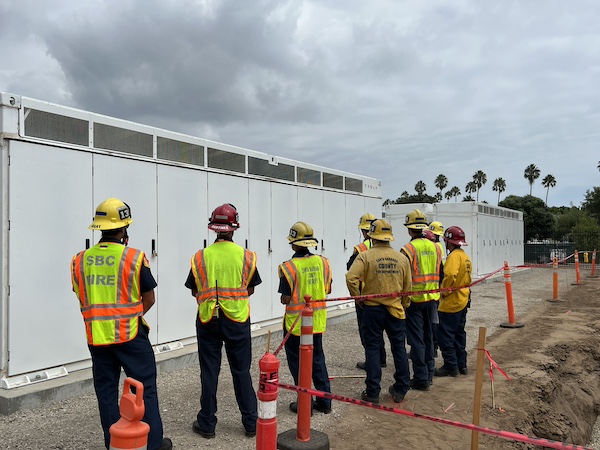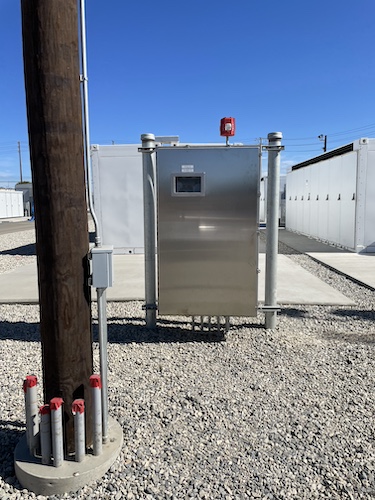Embracing New Fire Safety Standards for BESS
On April 19, 2019, a thermal runaway event took place in a battery energy storage unit (ESS) located within a building in Surprise, Arizona. The ESS was provided with fire detection and fire suppression, which both activated. Approximately five hours after arriving on the scene, the responding fire department opened a door on the ESS, and a deflagration event occurred, severely injuring four firefighters. The event was a catalyst for the need for updated fire safety standards, including increasing fire department awareness of the hazards of an ESS, as the ESS was reportedly installed in compliance with applicable codes and standards at the time of its commissioning.[1]
Just four months after this incident, the National Fire Protection Association (NFPA) debuted the first edition of NFPA 855, Standard for the Installation of Stationary Energy Storage Systems. The release of NFPA 855 was a three-year effort to address fire safety concerns related to ESS installation and operation. Since the release of NFPA 855, the model building and fire codes in the United States have also been updated to address these same concerns.

Whenever new regulations are issued, there is always a concern that these standards could be detrimental to business operations. The current edition of NFPA 855 applies to the “design, construction, installation, commissioning, operation, maintenance, and decommissioning of stationary energy storage systems (ESS), including mobile and portable ESS installed in a stationary situation”[2] to provide “the minimum requirements for mitigating the hazards associated with ESS”[3]. While NFPA 855 is a fire safety standard to protect people, property, and the environment from a thermal event, compliance with NFPA 855 can also have a positive effect on operational mission continuity. The key to NFPA 855 is to engage qualified professionals and the fire department early in the site development process.
Typically, there is a three year or more lag between the development of codes and standards like the International Fire Code and NFPA 855; many jurisdictions in the U.S. have not yet adopted the most current editions of these fire safety standards. Developers may be aware of these codes and standards or, more importantly, that the current editions provide more guidance on proper site location and interface with the responding fire department. Not understanding that these standards exist (or their requirements) can not only delay commissioning and start-up, but also require modifications of the installed ESS.
A key focus of the fire safety standards has to do with preventing “thermal runaway.” This is when the temperature of a battery cell increases uncontrollably which can result in a fire, explosion, or flammable and toxic gas evolution if not properly mitigated. Numerous media stories have shown the effects of thermal runaway in batteries for e-mobility devices (e-bikes, e-scooters, and similar). Thermal events in e-mobility devices, particularly when occurring inside a building, have resulted in significant fires, injuries, and deaths.
Fires in battery ESS units, however, are very rare. According to the BESS Failure Event Database maintained by the Electric Power Research Institute (EPRI)[4], there have only been 16 documented battery ESS failure events in the U.S. in the five years since the Surprise, Arizona event. While this number is higher than fire safety professionals would prefer, proper planning can limit the effect of a thermal event on the public and responding fire department.
 Planning at procurement
Planning at procurement
Early in the project planning process, developers and integrators work together to determine the overall site parameters, such as the type and manufacturer of the ESS and the quantity and location of the units on the site. All of these are key parameters in developing the fire safety concept for the site. Therefore, understanding and applying the requirements of NFPA 855 at this stage is key to a successful project.
NFPA 855 includes the development and review of items such as:
- Emergency planning and training
- Hazard mitigation analysis (HMA)
- Combustible storage
- Equipment
- Installation
- Smoke and fire detection
- Explosion Control
- Fire control and suppression
Successful implementation of NFPA 855 begins with the selection of the battery ESS. As technology continues to change and improve, battery ESS are constantly evolving with battery chemistry, energy storage capacity, energy storage management systems, and safety features. Some battery ESS have internal fire safety features such as hazardous gas venting, smoke detection, fire suppression, or specialized engineered solutions, while others may need these systems provided independently from the battery ESS.
Determining the need for these fire safety features starts with fire testing of the battery ESS. Most battery ESS units are now required by NFPA 855 and model fire codes to be listed to UL 9540, Energy Storage Systems and Equipment[5]. While there is an allowance in NFPA 855 for a field evaluation to be performed for non-listed ESS, UL 9540 requirements provide valuable information related to how the battery ESS reacts in a thermal event.
As part of the site development process, a hazard mitigation analysis (HMA) should be performed that reviews the results of the UL 9540A testing and applies that information to the individual battery ESS, adjacent units, and the overall site. The HMA is an analysis that looks at the consequences of a variety of failure modes, including thermal runaway. The HMA will assist in siting of the battery ESS to protect exposures on the site by determining the minimum distance from items such as public walkways, lot lines, important structures, adjacent battery ESS, and combustible materials. Depending on site constraints, the location of the battery ESS may be easily adjusted to accommodate these distances. In other cases, mitigating factors may need to be provided (such as a fire-resistive wall) to protect exposures.
Identifying these separation distances and/or mitigating factors, and adjusting for them early in the site development process, is key to a successful permit issuance and timely commissioning and approval by the local fire department. Developing the HMA late in the construction process can result in the installation/provision of significant mitigating factors (installation of fire-resistive walls, field evaluation of the battery ESS, addition of fire detection/fire suppression systems) after the battery ESS is installed on-site. This can easily delay project commissioning and start-up.
Final thoughts
While NFPA 855 and associated fire codes and standards can appear to cause additional headaches and costs for energy storage site developers and integrators, it saves you later. Early understanding and implementation of these regulations increase interaction and understanding with the responding fire department, which can result in successful project commissioning and start-up. If a thermal event were to occur, implementation of the HMA can result in limited downtime and any effect on adjacent equipment at the project site, as the event may be contained to a single energy storage unit.
Doug Fisher is the Principal Fire Protection Engineer at Bowman.
Bowman | bowman.com
[1] Four Firefighters Injured In Lithium-Ion Battery Energy Storage System Explosion – Arizona, July 28, 2020, UL Firefighter Safety Research Institute, Columbia, MD.
[2] NFPA 855, Standard for the Installation of Stationary Energy Storage Systems, 2023 edition, National Fire Protection Association, Quincy, MA
[3] NFPA 855, Standard for the Installation of Stationary Energy Storage Systems, 2023 edition, National Fire Protection Association, Quincy, MA
[4] https://storagewiki.epri.com/index.php/BESS_Failure_Event_Database
[5] Underwriters Laboratories Inc., 333 Pfingsten Road, Northbrook, IL 60062-2096
Author: Doug Fisher
Volume: 2024 May/June











